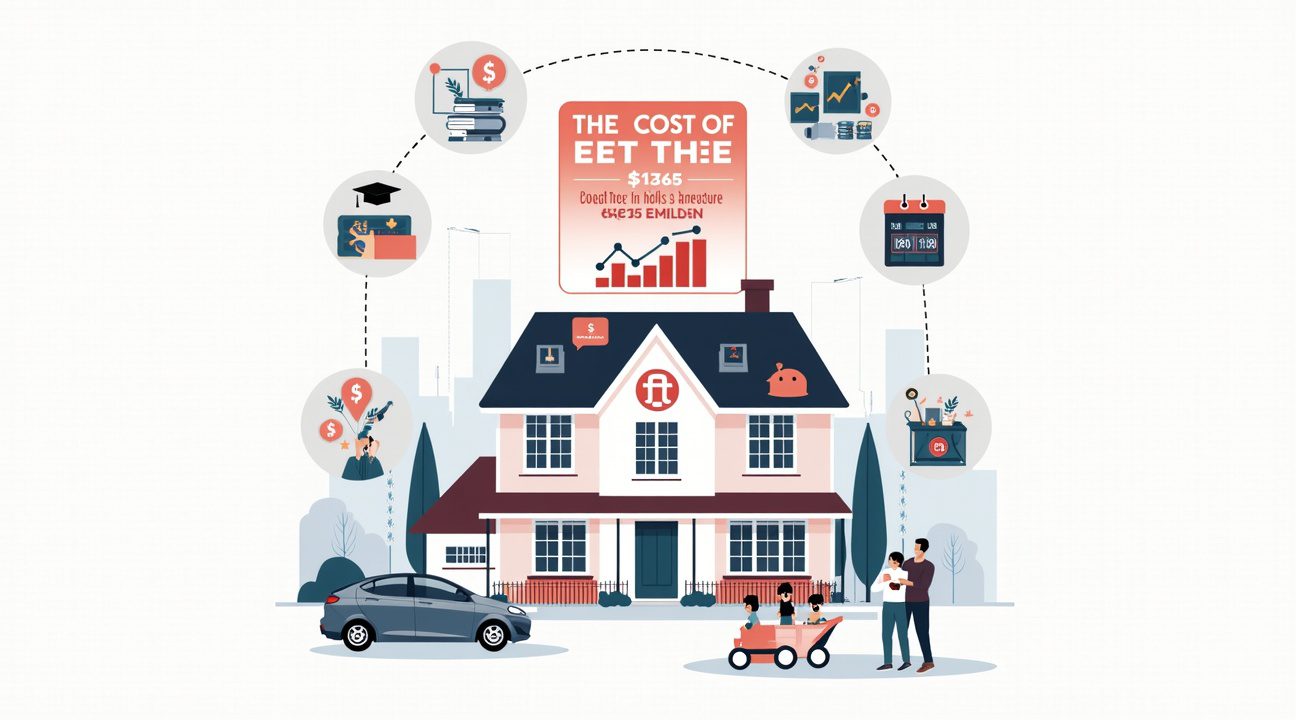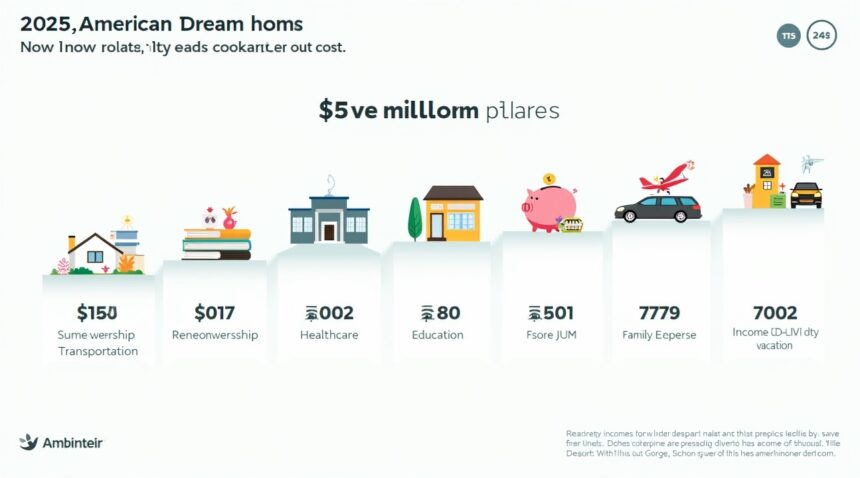The American Dream now comes with a formidable $5 million price tag in 2025, marking a sharp rise from $4.4 million in 2024 and nearly 50% growth over just two years. This significant shift, reported by Investopedia, highlights the growing financial strain on traditional middle-class aspirations such as homeownership, education, healthcare, and retirement. With average lifetime earnings of only $2.8 million for individuals holding a bachelor’s degree, achieving this dream remains out of reach for many Americans.
Key Takeaways
- The American Dream is now estimated at $5,043,323 in 2025, with retirement being the most expensive component at $1.6 million, and homeownership close behind at $957,594.
- Affordability remains elusive for most Americans, as the median household income of $84,000 would require 60 years of continuous work to meet the standard dream cost—well beyond the average 40-year career span.
- Housing and healthcare are the biggest cost drivers, with median home prices at $415,000 and projected lifetime healthcare costs reaching $414,208.
- Dual-income, college-educated households fare significantly better in approaching this financial benchmark, while single-income families face daunting challenges in achieving the same goals.
- Strategic financial planning is more critical than ever, requiring a focus on individual priorities, income growth, and long-term investment tactics to close the gap between aspirations and earnings.
Financial Realities for American Families
Even with prudent budgeting and saving, most families fall short of the financial threshold needed to achieve this modern version of the American Dream. The report suggests not only a growing income disparity, but also a shifting definition of financial stability.
Emphasis on Strategic Planning
Investopedia emphasizes that modern Americans must embrace robust financial strategies. This includes maximizing income opportunities, minimizing debt, and investing wisely to align their personal goals with economic realities. Financial literacy and planning tools have thus become essential components in navigating these rising costs.
The Staggering $5 Million Price Tag: What the American Dream Actually Costs in 2025
I’ve watched the cost of achieving the American Dream skyrocket to unprecedented levels, and the latest numbers from Investopedia paint a sobering picture of modern financial reality. The comprehensive analysis reveals that pursuing traditional middle-class aspirations now carries a lifetime price tag of $5,043,323 in 2025.
This figure represents a staggering jump from previous years. I observed the cost climb from $3.4 million in 2023 to $4.4 million in 2024, and now it’s reached over $5 million—a nearly 50% increase in just two years. That’s approximately a $600,000 year-over-year spike that’s forcing millions of Americans to reconsider their financial strategies and life goals.
How Investopedia Calculated These Eye-Opening Numbers
Investopedia’s methodology involved analyzing extensive government data alongside survey responses from over 1,200 U.S. adults to determine what constitutes the modern American Dream. I find their approach particularly comprehensive because it captures both statistical realities and personal aspirations that drive financial decisions.
The research team examined multiple data sources to build their calculations. Government statistics provided the foundation for housing costs, education expenses, and healthcare projections. Survey responses helped identify what Americans actually consider essential components of their dream lifestyle, from homeownership to retirement security.
Breaking Down the Components Behind the $5 Million Figure
I’ve analyzed how these massive costs accumulate across a typical American lifetime, and the breakdown reveals several key expense categories that drive the total upward:
- Housing expenses continue to dominate the calculation, including mortgage payments, property taxes, maintenance, and utilities over decades of homeownership
- Education costs encompass both personal college expenses and funding children’s higher education, reflecting the rising price of university tuition
- Healthcare expenses project lifetime medical costs, insurance premiums, and long-term care needs that extend well into retirement years
- Transportation costs include vehicle purchases, maintenance, insurance, and fuel expenses throughout working years
- Retirement savings requirements calculate the nest egg needed to maintain middle-class living standards after leaving the workforce
- Family expenses cover child-rearing costs from birth through college, including daycare, activities, and basic living expenses
Each category has experienced significant inflation pressures over recent years. I’ve noticed that housing costs alone have surged due to limited inventory and rising interest rates, while education expenses continue climbing faster than general inflation rates. Healthcare costs present another major challenge, with insurance premiums and out-of-pocket expenses creating substantial financial burdens for families.
The dramatic increase from $4.4 million to over $5 million in just one year demonstrates how quickly economic conditions can shift the financial landscape. I believe this rapid escalation reflects broader economic pressures including inflation, supply chain disruptions, and shifting labor markets that affect every aspect of American life.
For those looking to manage these escalating costs, I recommend exploring hidden ways to save money that might help offset some of these tremendous expenses. Additionally, understanding key trends developing in global equity markets can provide insights into investment strategies that might help build the necessary wealth over time.
The $5 million price tag isn’t just a number—it represents the financial reality facing American families who aspire to homeownership, quality education, healthcare security, and comfortable retirement. I see this figure as a wake-up call for individuals, policymakers, and financial institutions to address the growing gap between middle-class aspirations and economic accessibility.
These calculations underscore why financial planning has become more critical than ever. I encourage anyone pursuing these traditional milestones to start early, invest strategically, and consider alternative approaches to achieving their version of the American Dream within their means.

Breaking Down the Eight Financial Pillars of Middle-Class Life
I’ve examined the latest financial breakdown that reveals how the American Dream’s price tag has evolved into eight distinct categories, each representing a core component of middle-class aspirations. These pillars demonstrate the substantial financial commitment required to achieve what many consider a comfortable lifestyle in modern America.
The largest expense centers on retirement preparation, demanding $1,636,881 to fund a comfortable 20-year retirement period. This figure represents an increase from $1,599,995 in 2024, reflecting the growing challenge of maintaining living standards after leaving the workforce. Homeownership follows as the second-largest investment at $957,594, assuming the purchase of an existing single-family home with traditional financing terms including a 30-year mortgage and 20% down payment.
Transportation and Family-Related Expenses Lead Secondary Costs
Transportation costs through new car purchases total $900,346, marking a significant jump from $811,440 in 2024. This calculation assumes replacing vehicles every five years throughout adulthood, though it excludes ongoing expenses like fuel and maintenance. Family formation represents another substantial financial commitment, with raising two children and funding their college education reaching $876,092. This amount covers all expenses through age 18 plus four years of public college tuition for each child.
Healthcare emerges as a newly tracked category in 2025, requiring $414,208 throughout a lifetime. I find this addition particularly significant as it acknowledges medical expenses that weren’t previously calculated in American Dream cost assessments. Annual vacations contribute $180,621 to the total, assuming yearly trips from ages 22 through 84, while pet ownership adds $39,381 for lifetime care of one dog and one cat.
Wedding expenses represent the smallest pillar at $38,200, actually decreasing from $44,300 in 2024. This category encompasses ceremony costs, reception expenses, and engagement ring purchases. For those looking to reduce these substantial financial burdens, exploring hidden ways to save money can provide valuable strategies to make these goals more achievable while maintaining quality of life expectations.

The Mathematical Reality: Why Most Americans Can’t Afford Their Dreams
I’ve examined the stark numbers behind America’s financial aspirations, and they reveal a troubling disconnect between dreams and economic reality. The average lifetime earnings for Americans holding a bachelor’s degree totals $2.8 million—falling significantly short of the $5 million required for the modern American Dream by approximately $2.2 million.
This earnings gap becomes even more pronounced when I analyze current income trajectories. In 2024, the median household income reached $84,000, but at this rate, families would need 60 working years to accumulate the necessary $5 million. That timeline extends far beyond the typical 40-year career span from ages 25 to 65, creating an impossible mathematical equation for most Americans.
Gender and Educational Disparities Compound the Challenge
The situation becomes more complex when I break down earnings by gender and education level. Men with bachelor’s degrees earn approximately $3.3 million over their lifetime, while women with identical qualifications earn about $2.4 million—a substantial $900,000 difference that further complicates affordability calculations.
These disparities mean that single-income households face nearly insurmountable barriers to achieving traditional middle-class benchmarks. I’ve found that only dual-income, college-educated households are realistically positioned to approach the $4.4 million threshold, and even then, success isn’t guaranteed.
Consider the practical implications:
- A household where both partners hold bachelor’s degrees might theoretically earn $5.7 million combined over their careers.
- This calculation assumes consistent employment and steady income growth.
- It does not account for the substantial costs associated with earning and maintaining that income level, such as:
- Taxes
- Student loan payments
- Career interruptions due to caregiving or health issues
For those looking to bridge this financial gap, exploring hidden ways to save money becomes essential. Additionally, understanding key trends in global equity markets can help families make informed investment decisions to supplement their earnings.
The median household income of $84,000 represents the midpoint of American earnings, meaning half of all families earn less than this amount. For these households, the American Dream’s price tag represents an even more daunting challenge, requiring innovative approaches to wealth building and careful financial planning to make meaningful progress toward their goals.

Housing and Healthcare: The Biggest Cost Drivers Behind the Price Surge
Two critical components now dominate the escalating costs of achieving the American Dream in 2025: housing and healthcare expenses. These sectors have experienced unprecedented price increases that fundamentally reshape what families must budget for when pursuing traditional milestones of financial success.
Housing markets across the nation present formidable challenges for aspiring homeowners. The median home price currently sits at $415,000, while the national median list price reaches $429,990—figures that remain relatively flat compared to the previous year but represent massive growth over longer timeframes. Since 2019, home prices have surged by a staggering 36%, creating significant barriers for first-time buyers and those looking to upgrade their living situations.
Mortgage interest rates compound these challenges, standing at 6.26% and dramatically affecting affordability calculations. Economist Jake Krimmel of Realtor.com emphasizes how these rising costs across housing, healthcare, and education sectors make it increasingly difficult for families to accumulate savings. The mathematics behind homeownership reveal stark realities: over a 30-year loan period, total payments often approach nearly double the home’s original sticker price, turning a $415,000 purchase into an $800,000+ commitment when accounting for interest payments.
The Per-Square-Foot Reality
Space itself has become exponentially more expensive, with price per square foot rising by over 50% within just six years. This metric illustrates how housing affordability has deteriorated even for families willing to accept smaller living spaces. Buyers can no longer simply downsize their way to affordability—the fundamental cost of residential square footage has outpaced income growth across most demographics.
These housing market dynamics create ripple effects throughout household budgets. Families spend larger portions of their income on hidden expenses related to homeownership, from property taxes to maintenance costs that scale with property values. Higher mortgage payments strain discretionary spending, affecting everything from education funding to retirement savings contributions.
Healthcare represents the second major cost driver, newly incorporated into American Dream calculations at $414,208. This addition reflects growing recognition that medical expenses constitute a fundamental component of middle-class financial planning. Healthcare costs have mounted steadily, driven by factors including prescription drug prices, specialist care fees, and insurance premium increases that outpace general inflation rates.
The inclusion of healthcare expenses in American Dream calculations acknowledges a shift in how families must approach long-term financial planning. Medical costs no longer represent occasional unexpected expenses but rather predictable, substantial line items that require dedicated budgeting strategies. Insurance deductibles, copayments, and procedures not covered by standard plans accumulate into significant annual expenditures for typical families.
These dual pressures from housing and healthcare create compounding effects on household financial stability. Families facing higher mortgage payments simultaneously confront mounting medical bills, leaving less room for emergency funds or investment opportunities. The traditional path of building wealth through homeownership becomes more precarious when combined with healthcare cost obligations that persist regardless of employment status or economic conditions.
Economic analysts note how these cost drivers influence broader market trends, as consumer spending patterns shift to accommodate housing and healthcare priorities. Discretionary spending decreases when families allocate larger budget percentages to these essential categories, affecting everything from retail sales to entertainment industry revenues.
Housing and healthcare cost increases also create geographic disparities in American Dream accessibility. Areas with lower housing costs often feature limited healthcare infrastructure, while regions with comprehensive medical facilities typically command premium housing prices. This dynamic forces families to choose between affordable housing and accessible healthcare, complicating decisions about where to establish roots and pursue long-term financial goals.
The convergence of these cost pressures suggests that traditional approaches to achieving the American Dream require fundamental recalibration. Families must now factor healthcare expenses alongside housing costs when evaluating their capacity to pursue homeownership, education funding, and retirement planning simultaneously.
The Upper Middle Class Paradox: When Wealth Doesn’t Equal Success
Today’s upper middle class finds itself trapped in an unprecedented financial paradox. Despite accumulating more wealth than previous generations, these households struggle to achieve traditional middle-class milestones that their parents accomplished with relative ease.
The Disconnect Between Wealth and Purchasing Power
Nick Maggiulli of Ritholtz Wealth Management captures this disconnect perfectly, noting that “the economy wasn’t built to handle this many people with this much money.” This observation highlights a fundamental shift in how wealth functions in modern America. While more Americans hold substantial assets than ever before, the cost structure for essential life goals has outpaced even significant wealth accumulation.
The upper middle class now faces what economists describe as an existential crisis. Families earning six-figure incomes find themselves unable to afford homes in desirable neighborhoods, struggle to fund their children’s education without debt, and question whether retirement savings will suffice. These challenges persist despite having investment portfolios and savings strategies that would have guaranteed prosperity decades ago.
The Modern Economic Squeeze
This phenomenon represents more than just inflation or market volatility. The financial stability that once defined middle-class success has become increasingly elusive, even for high earners. Housing costs in metropolitan areas consume disproportionate portions of household income, while healthcare, education, and childcare expenses continue rising faster than wages or investment returns.
The middle-class squeeze affects decision-making at every level. Professionals delay homeownership, postpone having children, or relocate to less expensive regions to maintain their desired lifestyle. These choices reflect a broader economic transformation where traditional wealth markers no longer guarantee access to traditional middle-class experiences.
Understanding market trends becomes essential for navigating this landscape, yet even sophisticated investors find themselves questioning whether conventional financial planning approaches remain viable. The economic system’s inability to accommodate widespread wealth accumulation creates unique challenges that require adaptive strategies rather than historical benchmarks for financial success.
This paradox reshapes expectations about what wealth can accomplish, forcing a redefinition of financial security in contemporary America.
From Dream to Reality: Strategic Planning for the $5 Million Challenge
The American Dream has transformed dramatically since James Truslow Adams first defined it in 1931 as the hope for “a better, richer life for all.” What began as a vision of opportunity and prosperity has evolved into a financial challenge that demands strategic planning and disciplined execution. Modern households face a stark reality where achieving this dream requires careful calculation and purposeful action rather than wishful thinking.
Defining Your Personal Financial Vision
Rather than becoming overwhelmed by the $5 million price tag, individuals benefit from creating their own definition of success. Caleb Silver, editor-in-chief at Investopedia, emphasizes that “everybody’s dream actually has a different price tag,” highlighting the importance of personal goal-setting in financial planning. This approach requires honest assessment of what truly matters: homeownership, quality education for children, comfortable retirement, or entrepreneurial ventures.
Smart planners start by listing specific milestones and assigning realistic dollar amounts to each goal. A family might prioritize:
- $400,000 home
- $200,000 in education costs
- $1.5 million for retirement
Breaking down the dream into measurable components makes the challenge less intimidating and more achievable. This process also reveals which goals deserve immediate attention and which can be pursued later.
Building Wealth Through Income and Investment Strategy
With median household income at $84,000, families must leverage both steady earnings and investment returns to bridge the gap between current resources and future aspirations. Relying solely on wages won’t generate sufficient wealth within a reasonable timeframe. Successful wealth building requires a dual approach that maximizes earning potential while putting money to work through strategic investments.
Income optimization involves several key strategies that can significantly impact long-term financial outcomes:
- Pursuing skill development and education that leads to higher-paying positions
- Creating multiple income streams through side businesses or freelance work
- Maximizing employer benefits like 401(k) matching and health savings accounts
- Negotiating salary increases and taking calculated career risks for advancement opportunities
Investment planning becomes crucial for closing the wealth gap that income alone cannot fill. Starting early allows compound interest to work its magic, but even late starters can make significant progress with disciplined saving and smart asset allocation. Those looking for hidden ways to save money often discover opportunities that free up additional funds for investment purposes.
Stock market participation through diversified portfolios historically provides returns that outpace inflation and wage growth. Understanding key trends developing in global equity markets helps investors make informed decisions about asset allocation and timing. Real estate investment, whether through direct ownership or REITs, offers another avenue for wealth accumulation while providing potential tax advantages.
The path from dream to reality requires patience, discipline, and adaptability. Economic conditions change, personal circumstances evolve, and investment performance fluctuates. Successful wealth builders adjust their strategies while maintaining focus on long-term objectives. They understand that setbacks are temporary and that consistent action over time produces remarkable results.
Regular review and adjustment of financial plans ensures progress stays on track. Annual assessments allow for course corrections and goal refinements based on changing circumstances or new opportunities. Technology makes this process easier through budgeting apps, investment platforms, and financial planning software that provide real-time insights into progress.
The $5 million American Dream might seem daunting, but breaking it into manageable pieces and executing a well-planned strategy makes it achievable for determined individuals. Success comes from understanding personal priorities, maximizing income potential, and letting investments compound over time.

Sources:
Investopedia – The Staggering $5 Million Price Tag: What the American Dream Actually Costs in 2025
Investopedia – Breaking Down the Eight Financial Pillars of Middle-Class Life
Investopedia – The Mathematical Reality: Why Most Americans Can’t Afford Their Dreams
Realtor.com – Housing and Healthcare: The Biggest Cost Drivers Behind the Price Surge
Ritholtz Wealth Management – The Upper Middle Class Paradox: When Wealth Doesn’t Equal Success
Investopedia – From Dream to Reality: Strategic Planning for the $5 Million Challenge


